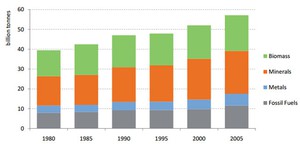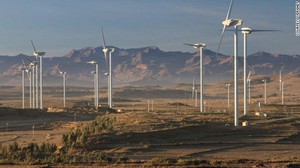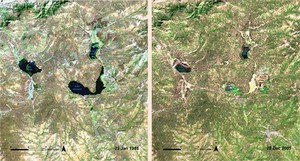Use of natural resources
We use many different types of natural resources in our daily lives. We depend on food and water for survival and we need energy for many different purposes, from domestic cooking through to major industrial processes. Our clothes, transport, buildings, tools and all other items we use require many different resources for their production. Let’s take a simple example. Think about the resources that have been used to produce a notebook of the type you may be using right now as you study this Module. Manufacturing the paper needed raw materials of wood and water as well as energy for the production process. The trees that supplied the wood required soil, water and land to grow on. There may be ink or metal staples or other components in your notebook that were made from other types of resources. Our need for resources is vast and it is growing as the population increases and consumption per person increases with socio-economic progress. Depletion of natural resources by extraction and exploitation is especially of concern for non-renewable resources (see Box 1.1).
Box 1.1 Renewable and non-renewable resources
The resources we use can be classified as renewable or non-renewable. The basic difference between the two is the rate at which they are regenerated back into a usable form, relative to the rate at which they are used by humans. Non-renewable resources cannot be replenished by natural means as quickly as the rate at which they are consumed. They include minerals and fossil fuels such as oil, coal and gas, which are formed over millions of years by natural processes from decayed plants and animals.
Renewable resources are constantly available or regenerated over short timescales by natural processes. Some renewable resources, such as solar energy, are not modified or used up by humans. Others, such as water, are altered when we use them and can be over-exploited or damaged such that the resource is no longer available for use.
Can you suggest some other renewable resources that are replenished naturally but need to be managed properly and not over-exploited?
You may have suggested examples such as wood, animals and plants. For example, trees are cut down to provide wood and they will regrow but they need time to regenerate.
Globally, both population and resource extraction increased by almost 50% in the 25 years from 1980 to 2005 (SERI et al., 2009). Over that time, the world population increased from 4.44 billion in 1980 to 6.49 billion. Figure 1.2 shows how the extraction of natural resources increased between 1980 and 2005 from 40 billion tonnes to 58 billion tonnes. The graph shows the extraction of four types of natural resource: fossil fuels, biomass, metals and minerals. Biomass means biological material derived from living organisms such as crops, livestock, fish, wood, etc. Metals are used in the manufacture of a wide range of goods – from cars to computers. Minerals are used in industrial processes and in construction to build our houses and roads. Both metals and minerals are obtained from rocks that have been mined and are then processed in various ways to extract the valuable resource.

Figure 1.2 Global extraction of natural resources, 1980 to 2005. (SERI et al., 2009)
Look at Figure 1.2. What is the pattern of natural resource extraction from 1980 to 2005 and what do you think could be the reason?
Natural resource extraction shows a steady increase from 1980 to 2005, with the greatest amount extracted in the most recent year (2005). The most likely reason is the increase in the global population in this period; more people need more resources. It could also be the case that the amount used by individuals and by wider society is increasing due to changes in behaviour and levels of consumption.
Advances in technology have increased natural resource exploitation by enabling people to reach new resources and to exploit more resources per capita (per person). For example, fishermen who use traditional technologies such as small boats are limited in the number of fish they can catch. Modern industrial fishing fleets use very large ships that cover huge areas of ocean at greater depths to catch many more fish. This can lead to overfishing, which means catching fish at a faster rate than they can reproduce.
Are fish a renewable or non-renewable resource?
Fish are a renewable resource. However, if fishing is not managed properly and more fish are taken from the water than can be replaced naturally, the fishery will fail.
Overfishing and other examples of over-exploitation of natural resources can result in damage to or the loss of entire ecosystems.An ecosystem includes all the living organisms (humans, plants, animals, micro-organisms) and their physical environment (soil, water, air, land) and the interactions between them. If one component of the system is removed, this can have knock-on effects on the other parts of the system.
Deforestation
One particular problem caused by over-exploitation of natural resources is deforestation, which occurs when forest areas are cleared and the trees are not replanted or allowed to regrow. In Ethiopia, clearing land for agriculture to meet the food needs of the growing population and the demand for fuel and construction materials has resulted in a steady loss of forest area, which is still continuing as you can see from Figure 1.3.

Figure 1.3 Proportion of land area in Ethiopia covered by forest (%) from 2002 to 2010. (MoFED, 2012a)
The loss of forest has several undesirable consequences. Forests are home to many different types of trees, as well as other plants, and a wide range of animals from insects to birds and mammals. The conversion of forests to agriculture greatly reduces biodiversity, which is a measure of the variety of living organisms (all life forms). Biodiversity is important for humans because we use other living organisms to provide several essentials:
- Food: we use plants and animals such as fish, goats, wheat, rice and maize as sources of food.
- Medicines: many traditional medicines are made from plants and animals and new medicines are developed from them.
- Ecological services: living organisms, especially plants and micro-organisms, play an important role in processes that maintain our lives and environment such as providing oxygen, cleaning the air, purifying water, breaking down wastes and controlling erosion.
Deforestation is a significant contributory cause of soil erosion. Once the trees and undergrowth are removed, the underlying ground is exposed. Without the intercepting effect of the vegetation and the tree roots binding the soil together, the soil is more likely to be washed away when it rains. Loss of forests also has a significant impact on water supply. Tree roots reach deep into the soil and create spaces between the particles which increases soil permeability, allowing rainwater to soak in and replenish groundwater. (Permeability means the ease with which water moves through soil or rock.)
Energy resources
The use of renewable or non-renewable resources is a critical factor when considering energy resources. Fossil fuels have been the main energy source for global industrialisation, but because they are non-renewable, the quantity is ultimately limited and their use is not sustainable over the long term. Furthermore, burning of fossil fuels is the main cause of climate change. (Climate change is discussed fully in later study sessions.) There are several renewable alternatives to fossil fuels. Wood used as a fuel is renewable in the sense that trees will regrow but there are other disadvantages such as deforestation, as you have read. In Ethiopia, windfarms are harnessing wind power to generate electricity (Figure 1.4) but the most important source of renewable energy in Ethiopia is water. Ethiopia already has several hydropower stations and more are planned, including the Grand Ethiopian Renaissance Dam, currently under construction. Hydroelectric power is renewable because it makes use of the energy of flowing water but does not use up the water in the process. Another renewable energy source is solar power, using photovoltaic cells that convert the sun’s energy into electricity.

Figure 1.4 Windfarm at Ashegoda, Tigray Region.
Water resources
You may have noticed that the four categories of resources shown in Figure 1.2 do not include water, and yet this is one of our most vital resources and is obviously central to the WASH sector. The direct use of water by people falls into three main categories:
- domestic uses, including drinking, washing and cooking
- agricultural uses, principally irrigation
- industrial uses, in manufacturing processes and for energy generation.
The relative proportions of these three categories vary in different parts of the world, but globally the sector using the most water is agriculture (FAO, 2012) (Figure 1.5).

Figure 1.5 Global water withdrawal by sector. (Adapted from FAO, 2012)
As well as direct use of water for human activities, water is also essential for the environment and to maintain biodiversity. Rivers, lakes and wetlands are important habitats for wildlife and need a minimum amount of water at all times. This becomes a problem when the demand for water for human activities exceeds the supply.
Water is not an endlessly renewable resource. In many parts of the world water demand is significantly above sustainable water supply. Sustainable water supply means there are adequate supplies, in both quality and quantity, to meet the current and future needs of people and of the environment.
Many countries are already experiencing water stress or scarcity. These terms refer to the volume of water available relative to the use and demand for it, which is linked to the population served. Figure 1.6 shows the availability of freshwater across the world. Countries which have less than 1700 m3 of water per person per year for all purposes are defined as water stressed (United Nations, 2014). Water scarce countries have been defined as those with less than 1000 m3 of water per person per year. These precise figures should be used with caution, however, because they do not recognise variations between countries and they hide the underlying causes of water scarcity.

Figure 1.6 Global freshwater availability in cubic metres (m3) per person per year (2007). (Note that although calculated ‘per person’, these figures apply to all uses of water not just personal use.) (WWAP, 2012)
Increasing water demand leads to unsustainable use of water resources. By the actions of the water cycle (which you will learn about in Study Session 4) water supply is replenished, but taking excessive amounts of water from rivers and groundwater for domestic, industrial and agricultural use decreases the amount of water available for current and future generations. Globally, water withdrawals have tripled over the last 50 years due to population growth and to increased consumption per person. Many areas with plentiful supplies can sustain this use, but in some countries the future may bring water shortages unless demand is managed.
If the trend for increased consumption continues, what could be the result for Ethiopia?
As you can see from Figure 1.6, Ethiopia is already classed as being under water stress. If consumption increases due to population growth and/or increased use per person, this could put Ethiopia into the water scarcity category.
In practice, for Ethiopia, the problem of water supply is not so much about the volume of water that is available. The problem is the infrastructure and investment required in delivering adequate quantities of safe water to all the people wherever they live. The availability of water and access to a safe supply varies considerably throughout the country and between rural and urban populations.
Case Study 1.1 illustrates the problems that can arise from excessive water use.
Case Study 1.1 Effects of water use on Lake Alemaya
Lake Alemaya in the Ethiopian Highlands has always provided local people with water for drinking and domestic use, for irrigating crops, watering livestock and fishing. In the mid-1980s it was around 8 m deep and covered 4.72 km2. However, by 2005 the amount of water in the lake had dropped dramatically (Figure 1.7) and the size of the lake had fallen (UNEP, n.d. 2).

Figure 1.7 Loss of water from Lake Alemaya, between 1986 and 2005. (UNEP, n.d. 2)
It is believed that changes in water use by local people and changes in the local climate are responsible. The use of domestic water and also water for irrigation (especially for growing khat) has increased significantly. Deforestation of the surrounding area, as land is cleared for farming and to meet an increasing need for wood, means that tree roots no longer hold the soil together and it is washed off the hillsides into the lake. This causes it to silt up and reduces the capacity of the lake. Warming of the local climate may also have had an effect, increasing the rate of evaporation from the lake. Recently, lack of water in the lake has interrupted water supply to Harar, a nearby town of over 100,000 people.
What are the possible causes of the loss of water from Lake Alemaya?
Increased use of water for domestic uses and for irrigation, deforestation leading to soil erosion and silt deposition in the lake, and possibly climate change.